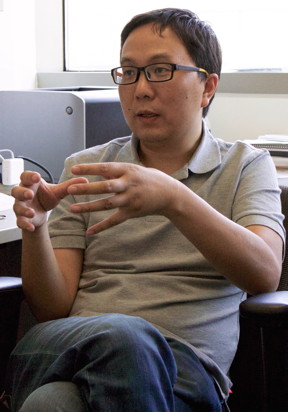Home > Press > UCLA study could lead to a new class of materials for making LEDs: Researchers are first to demonstrate electroluminescence from multilayer molybdenum disulfide
 |
| CNSI Xiangfeng Duan |
Abstract:
Over the last decade, advances in the technology of light-emitting diodes, or LEDs, have helped to improve the performance of devices ranging from television and computer screens to flashlights. As the uses for LEDs expand, scientists continue to look for ways to increase their efficiency while simplifying how they are manufactured.
UCLA study could lead to a new class of materials for making LEDs: Researchers are first to demonstrate electroluminescence from multilayer molybdenum disulfide
Los Angeles, CA | Posted on July 18th, 2015A new study by researchers from the California NanoSystems Institute at UCLA is the first demonstration of electroluminescence from multilayer molybdenum disulfide, or MoS2, a discovery that could lead to a new class of materials for making LEDs. The study, led by Xianfeng Duan, professor of chemistry and biochemistry, was published in the journal Nature Communications on July 1, 2015.
In its single-layer form, molybdenum disulfide is optically active, meaning that it emits light when electric current is run through it or when it is shot with a nondestructive laser. Multilayer molybdenum disulfide, by contrast, is easier and less expensive to produce, but it is not normally luminescent. In the new study, Duan and first author Dehui Li, a postdoctoral scholar in Duan’s lab, created the first multilayer molybdenum disulfide device that shows strong luminescence when electrical current is passed through it.
“We were trying to make a vertically stacked light-emitting device based on monolayer MoS2, but it was difficult to get the efficiency as high as we wanted,” Duan said. “On the other hand, it was rather surprising for us to discover that similar vertical devices made of multilayer MoS2 somehow showed very strong electroluminescence, which was completely unexpected since the multilayer MoS2 is generally believed to be optically inactive. So we followed this new lead to investigate the underlying mechanism and the potential of multilayer MoS2 in light-emitting devices.”
Duan and his team used a technique called electric field-induced enhancement, which relocates the electrons from a dark state to a luminescent state, thereby increasing the material’s ability to convert electrons into light particles, or photons. With this technique, the multilayer MoS2 semiconductors are at least as efficient as monolayer ones.
Duan’s team is currently moving forward to apply this approach to similar materials, including tungsten diselenide, molybdenum diselenide and tungsten disulphide, with the goal of helping to create a new generation of light-emitting devices from two-dimensional layered materials, which are less expensive and easier to use in manufacturing.
####
For more information, please click here
Contacts:
Shaun Mason, CNSI
310-794-5346
Copyright © UCLA
If you have a comment, please Contact us.Issuers of news releases, not 7th Wave, Inc. or Nanotechnology Now, are solely responsible for the accuracy of the content.
| Related News Press |
News and information
![]() Researchers develop molecular qubits that communicate at telecom frequencies October 3rd, 2025
Researchers develop molecular qubits that communicate at telecom frequencies October 3rd, 2025
![]() Next-generation quantum communication October 3rd, 2025
Next-generation quantum communication October 3rd, 2025
![]() "Nanoreactor" cage uses visible light for catalytic and ultra-selective cross-cycloadditions October 3rd, 2025
"Nanoreactor" cage uses visible light for catalytic and ultra-selective cross-cycloadditions October 3rd, 2025
Display technology/LEDs/SS Lighting/OLEDs
![]() Spinel-type sulfide semiconductors to operate the next-generation LEDs and solar cells For solar-cell absorbers and green-LED source October 3rd, 2025
Spinel-type sulfide semiconductors to operate the next-generation LEDs and solar cells For solar-cell absorbers and green-LED source October 3rd, 2025
Materials/Metamaterials/Magnetoresistance
![]() First real-time observation of two-dimensional melting process: Researchers at Mainz University unveil new insights into magnetic vortex structures August 8th, 2025
First real-time observation of two-dimensional melting process: Researchers at Mainz University unveil new insights into magnetic vortex structures August 8th, 2025
![]() Researchers unveil a groundbreaking clay-based solution to capture carbon dioxide and combat climate change June 6th, 2025
Researchers unveil a groundbreaking clay-based solution to capture carbon dioxide and combat climate change June 6th, 2025
![]() A 1960s idea inspires NBI researchers to study hitherto inaccessible quantum states June 6th, 2025
A 1960s idea inspires NBI researchers to study hitherto inaccessible quantum states June 6th, 2025
![]() Institute for Nanoscience hosts annual proposal planning meeting May 16th, 2025
Institute for Nanoscience hosts annual proposal planning meeting May 16th, 2025
Announcements
![]() Rice membrane extracts lithium from brines with greater speed, less waste October 3rd, 2025
Rice membrane extracts lithium from brines with greater speed, less waste October 3rd, 2025
![]() Researchers develop molecular qubits that communicate at telecom frequencies October 3rd, 2025
Researchers develop molecular qubits that communicate at telecom frequencies October 3rd, 2025
![]() Next-generation quantum communication October 3rd, 2025
Next-generation quantum communication October 3rd, 2025
![]() "Nanoreactor" cage uses visible light for catalytic and ultra-selective cross-cycloadditions October 3rd, 2025
"Nanoreactor" cage uses visible light for catalytic and ultra-selective cross-cycloadditions October 3rd, 2025
Photonics/Optics/Lasers
![]() ICFO researchers overcome long-standing bottleneck in single photon detection with twisted 2D materials August 8th, 2025
ICFO researchers overcome long-standing bottleneck in single photon detection with twisted 2D materials August 8th, 2025
![]() Institute for Nanoscience hosts annual proposal planning meeting May 16th, 2025
Institute for Nanoscience hosts annual proposal planning meeting May 16th, 2025
|
|
||
|
|
||
| The latest news from around the world, FREE | ||
|
|
||
|
|
||
| Premium Products | ||
|
|
||
|
Only the news you want to read!
Learn More |
||
|
|
||
|
Full-service, expert consulting
Learn More |
||
|
|
||








